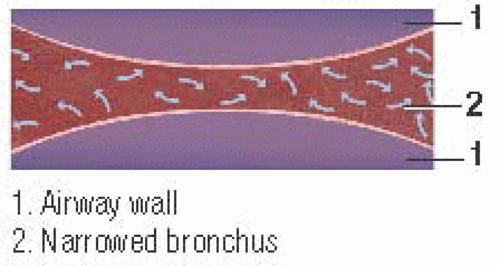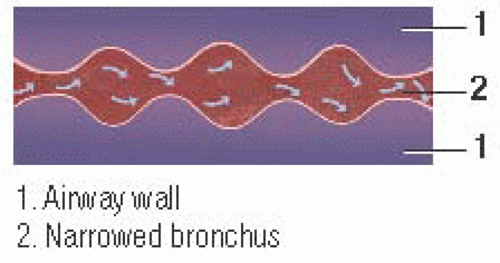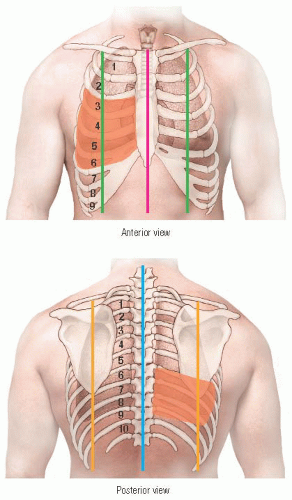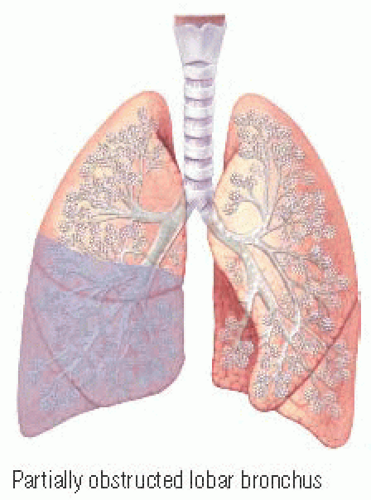Adventitious Sounds: Wheezes
1. Describe the mechanism that produces wheezing?
2. What conditions are associated with wheezes?
3. Describe the following types of wheezes: expiratory polyphonic, fixed monophonic, sequential inspiratory, and random monophonic.
4. What type of wheeze is associated with asthma?
5. Widespread airflow obstruction causes what type of wheezing?
6. Describe stridor.
SOUND PRODUCTION
Wheezes—which are associated with such conditions as bronchospasm, airway thickening caused by mucosal swelling or muscle hypertrophy, inhalation of a foreign body, tumor, secretions, and dynamic airway compression—are musical sounds generated by air passing through a bronchus so narrowed as to be almost closed. The bronchus walls oscillate between closed and barely open positions; these oscillations generate audible sounds.
Wheezes are musical, relatively high-pitched, continuous sounds with frequencies of ≥400 Hz and a duration of ≥250 milliseconds. Their duration is long enough to carry an audible pitch similar to a musical tone that may often sound like hissing. Wheezes are described by their timing within the respiratory cycle; they may be heard during inspiration or expiration or continuously throughout the respiratory cycle. Wheezes can be further described as localized or diffuse, episodic or chronic.
Frequency
A wheeze’s pitch is determined by the emitted sound’s frequency, which can vary widely over a five-octave range. These differences in frequency are attributed to the airway size and elasticity and to airflow rates through the narrowed bronchus. Theoretically, large, flabby, narrowed airways generate low-pitched sounds; stiff, narrowed airways generate high-pitched sounds. Pitch does not correlate to airway length, width, or to air density.
Transmission
Wheezes are transmitted better through airways than through lung tissue, which absorbs high-frequency sounds. Wheezes that sound louder over central airways than over peripheral lung tissue may be sounds transmitted through the central airways but are not produced by them. Wheezes heard at the mouth in severe airway obstruction may not be audible during auscultation of the chest wall surfaces.
Be alert for impending respiratory failure if wheezes are audible at the mouth and breath sounds are diminished or absent.
EXPIRATORY POLYPHONIC WHEEZES
Polyphonic wheezes are thought to be caused by the dynamic compression of large airways during expiration. In healthy individuals, polyphonic wheezes can sometimes be auscultated during a maximal forced expiration when the dynamic compression occurs simultaneously in all airways. No regional variations exist in airway resistance or in lung compliance; consequently, polyphonic wheezes are heard throughout the lungs during expiration.
Polyphonic wheezes are loud, musical, and widely transmitted; when heard during regular breathing, they indicate widespread airflow obstruction.
In patients with widespread airflow obstruction (as in asthma, chronic obstructive pulmonary disease, chronic bronchitis), elastic recoil properties, peripheral airway resistance, and airway mechanics are altered throughout both lungs. Together, these abnormal changes affect the timing of dynamic airway compression within the bronchi, which alters normal sound production. For example, during sequential forceful expirations, the central bronchi are compressed first when elastic recoil of the airways is low or when peripheral airway resistance is high. This compression produces a series of sounds, beginning with a monophonic wheeze and quickly followed by bitonal sounds. Soon, the full complement of sounds that make up polyphonic wheezes are audible through the stethoscope. These multiple musical tones begin simultaneously and maintain a constant pitch that rises sharply at the end of expiration. (♦Sound 92)
Sound characteristics
Expiratory polyphonic wheezes are usually heard over the anterior, posterior, and lateral chest wall surfaces during expiration. Their intensity is usually described as loud and musical, and their duration is continuous. They have a high pitch that is heard best using the diaphragm of the stethoscope. (♦Sound 93)
FIXED MONOPHONIC WHEEZES
Stay updated, free articles. Join our Telegram channel

Full access? Get Clinical Tree







